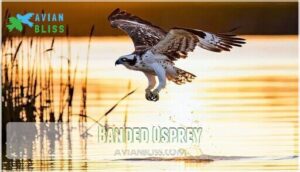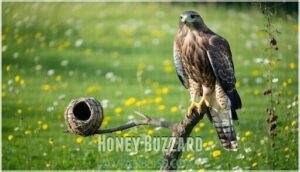This site is supported by our readers. We may earn a commission, at no cost to you, if you purchase through links.

You’ll find that larger species like red-tailed hawks often reach 15-20 years, while smaller hawks like sharp-shinned hawks average 8-12 years.
Their lifespan depends heavily on avoiding predators, finding adequate food, and steering clear of human-related dangers like power lines and vehicles.
Disease and parasites also play significant roles in limiting their years.
Notably, captive hawks can live considerably longer than their wild counterparts, sometimes reaching 25-30 years with proper veterinary care.
The oldest recorded hawk lived an impressive 29 years, revealing just how remarkable these raptors’ potential longevity can be when conditions align perfectly.
Table Of Contents
- Key Takeaways
- How Long Do Hawks Live?
- Hawk Longevity Overview
- Factors Affecting Hawk Lifespan
- Longest-Living Hawk Species
- Hawk Aging Studies and Challenges
- Average Lifespan of Common Hawk Species
- Captive Vs. Wild Hawk Longevity
- Conservation Efforts to Extend Hawk Lifespans
- Frequently Asked Questions (FAQs)
- How long do hawks live in captivity?
- How long do red shoulder hawks live?
- How long do red tailed hawks live?
- Do hawks live longer than other raptors?
- Do Hawk lifespan factors affect Hawk survival?
- Do Hawks have a long life expectancy?
- What is the lifespan of a hawk?
- What does it mean when a hawk hangs around your yard?
- Can a hawk pick up a 10 lb cat?
- What is the maximum age of a hawk?
- Conclusion
Key Takeaways
- You’ll find wild hawks live 10-20 years on average, with larger species, like red-tailed hawks, reaching 15-20 years, while smaller species, like sharp-shinned hawks, average just 3-8 years.
- Captive hawks dramatically outlive their wild counterparts, often reaching 20-30 years due to consistent veterinary care, regular nutrition, and protection from predators and environmental hazards.
- First-year survival rates are critically low for hawks, with up to 77% of juveniles dying before maturity due to inexperience in hunting, predation, and human-related threats, like vehicle collisions and power lines.
- Human activities pose the greatest threat to hawk longevity, including habitat destruction, vehicle strikes, poisoning from pesticides and rodenticides, and electrocution from power lines – far exceeding natural predation risks.
How Long Do Hawks Live?
Hawks’ longevity depends heavily on species, environment, and human interference.
You’ll find that larger hawk species generally outlive smaller ones, with hawk lifespan averaging 10-12 years in wild conditions.
However, Species Size Impact creates considerable variations—Red-tailed hawks live 10-15 years while Northern goshawks can reach 20-25 years.
Hawk Mortality Rates spike dramatically during the first year.
First-Year Survival remains critically low due to inexperience, predation, and starvation.
Young hawks often can’t hunt effectively, making roadkill their risky food source.
Environmental Toxin Effects severely impact hawk life expectancy.
Lead poisoning, pesticides, and rodenticides reduce average hawk age substantially.
Climate change further threatens food availability and habitat quality.
Captive Care Benefits dramatically extend hawk years—captive birds often live 20-30 years, with some reaching 38+ years.
Protection from predators, consistent nutrition, and veterinary care eliminate many wild threats.
Different hawk species lifespan ranges create fascinating survival patterns, from Cooper’s hawks (8-12 years) to Harris’s hawks potentially reaching nearly four decades in captivity.
Hawk Longevity Overview
Understanding hawk life expectancy reveals fascinating patterns across different species.
You’ll discover that these raptors typically live 10-20 years in wild conditions, though Species Variation creates dramatic differences in longevity potential.
Captivity Advantages become clear when comparing lifespans – captive hawks often reach 20-30 years, with some exceptional individuals surviving beyond 40.
The Aging Process in hawks follows predictable patterns, with Mortality Rates highest during their vulnerable first year.
Cooper’s Hawks, for instance, are known for their adaptability to urban environments, which can influence their survival rates.
Here’s what influences hawk natural lifespan:
- Lifespan Factors include genetics, environment, and food availability
- Larger hawk species generally achieve greater hawk maximum age
- Wild hawk years depend heavily on hunting success and territory quality
- Individual hawk lifespan varies considerably within each species
Your understanding of these patterns helps explain why conservation efforts focus on protecting both habitat quality and reducing human-related threats that cut short these magnificent birds’ potential longevity.
Factors Affecting Hawk Lifespan
You’ll find that several key factors substantially impact how long hawks live in both wild and captive environments.
Natural predators, human activities, and various diseases work together to determine whether a hawk reaches its potential lifespan or faces an early death, influenced by these factors that substantially impact their lives in the wild and in captive environments.
Natural Predators
From within the circle of life, natural predators substantially shape hawk lifespan through predator impact on vulnerable populations.
Nature’s predators sculpt hawk lifespans from their very first flight—survival becomes an unforgiving test of skill and instinct.
Great horned owls, eagles, and larger hawks create the most dangerous threats, especially targeting juvenile vulnerability during their critical first year.
Adult hawks can defend themselves, but nestlings are vulnerable when unattended.
Predation patterns reveal stark mortality statistics:
- Larger female sparrowhawks prey on unmated males
- Eggs and chicks are easy targets in nests
- Goshawks and eagle owls are the main predators of diurnal birds of prey
- Food chain disruptions can lead to starvation
- Climate change affects habitat and prey availability
Nest predation by raccoons, foxes, and snakes devastates hawk populations.
Competition effects intensify during breeding season when territorial disputes peak.
Up to 23% of juvenile Cooper’s hawks perish from predation, demonstrating how predator-prey dynamics control hawk mortality rate.
This ecosystem balance maintains nature’s checks, though it limits individual hawk lifespan potential.
Human Impacts
Human activities pose far greater threats to hawk survival than natural predators.
Habitat destruction eliminates vital hunting grounds, while vehicle collisions kill thousands annually.
Poisoning effects from pesticides and rodenticides weaken birds through contaminated prey. For those concerned about poisoning effects, consider rodent control alternatives.
Power lines create electrocution risks, and climate change reduces food availability.
These environmental threats substantially impact how long hawks live, with human impact accounting for most mortality factors that cut their natural lifespans short.
Collisions with vehicles account for a large percentage of bird deaths, with an estimated 89 million deaths occurring annually in the U.S.
Disease and Parasites
Beyond human threats, infectious diseases pose serious risks to hawk survival. Parasitic infections weaken immune systems, making hawks vulnerable to secondary health issues that reduce hunting success.
Disease impacts vary substantially across hawk populations:
- Frounce Disease – Trichomoniasis causes oral lesions and weight loss in 39.4% of migrating red-tailed hawks
- Aspergillosis Threat – Fungal infections create respiratory distress, particularly affecting captive birds
- Toxin Exposure – Environmental contaminants accumulate through prey consumption, causing organ damage
- Parasite Impact – Blood parasites like Haemoproteus reduce survival rates during critical migration periods
- Disease Prevention – Proper habitat management helps maintain healthier hawk populations
Young hawks face the highest mortality from these health challenges during their vulnerable first year.
Longest-Living Hawk Species
When you’re looking at hawk lifespans, certain species stand out as true record-breakers in the longevity department.
The Banded Osprey, Golden Eagle, and Honey Buzzard represent some of the longest-living raptors, with documented cases reaching well beyond the typical hawk lifespan of 10-12 years in the wild, making them notable for their longevity.
Banded Osprey
The oldest wild banded osprey reached 32 years, showcasing remarkable raptor lifespan among North American populations.
These "fish hawks" demonstrate exceptional longevity through their specialized hunting abilities and migratory resilience. Banding benefits scientists by tracking osprey identification and migration patterns across decades.
Ospreys exhibit a remarkable global habitat range, inhabiting every continent except Antarctica.
Key longevity factors include:
- Specialized fishing diet – reduces competition with other raptors
- Coastal habitat adaptability – access to consistent food sources
- Strong migratory instincts – successful long-distance travel abilities
- Reduced banding mortality – careful tracking minimizes research impact
Most ospreys average 7-10 years in wild conditions, making extreme longevity rare but scientifically valuable for understanding hawk lifespan patterns.
Golden Eagle
Golden eagles dominate as nature’s ultimate survivors, with wild specimens reaching 31 years and captive individuals living up to 68 years.
Their impressive raptor lifespan stems from diverse Golden Eagle Diet including mammals and birds, plus vast Golden Eagle Habitat spanning mountains and plains.
Advanced Hunting Strategies and Unique Adaptations like exceptional eyesight contribute to their longevity, though Conservation Status remains stable across most ranges.
Honey Buzzard
European honey buzzards showcase remarkable longevity in the wild, with banded individuals reaching 29 years.
Their Honey Buzzard diet of wasp and bee larvae provides unique nutritional advantages that support extended lifespans.
During Buzzard Migration, these raptors face Buzzard threats including goshawk predation and habitat loss.
Most survive only 9-10 years due to environmental factors affecting hawk lifespan, yet their specialized Buzzard Habitat adaptability enables some to achieve exceptional longevity records surpassing many hawk species.
Hawk Aging Studies and Challenges
The complexity of hawk aging research stems from methodological hurdles that researchers must navigate carefully.
Scientists use plumage-based age class systems and Bird Banding Lab Age Codes as their primary aging techniques, but these methods face significant limitations.
Molt cycles help categorize age groups, yet molt variability and nutrition differences create inconsistent developmental rates.
Banding programs provide valuable data, but recovering marked birds remains challenging due to hawks’ secretive nature and wide-ranging movements.
Age determination becomes particularly difficult when studying cellular senescence and genetic factors that influence the hawk aging process.
Researchers can’t easily measure aging biomarkers like telomere length or assess oxidative stress levels in wild populations without extensive capture efforts.
Key research challenges include:
- Hawks’ preference for dense vegetation complicates direct nest observation
- High juvenile mortality creates gaps in lifespan tracking data
- Biases in carcass collection affect mortality cause studies
- Capture stress may impact juvenile survival rates
- Secretive nesting behavior limits abundance data collection
These obstacles mean our understanding of hawk lifespan remains incomplete despite decades of study.
Average Lifespan of Common Hawk Species
You’ll find that common hawk species show surprising variation in their lifespans, with some living nearly three times longer than others.
The three most widespread North American hawks—red-tailed, Cooper’s, and sharp-shinned—each face unique challenges that directly impact how long they survive in the wild.
Red-Tailed Hawk
Throughout North America’s diverse landscapes, you’ll spot red-tailed hawks soaring with their distinctive russet plumage variations.
These apex predators live 10-12 years in wild conditions, though exceptional individuals reach 30 years. Their hunting techniques involve patient perching before swift dives at prey.
Adult hawk lifespan increases substantially in captivity, extending to 20-25 years. Territory size spans several square miles, where mating rituals include aerial displays.
This redtailed hawk represents North America’s most successful raptor species. These birds have distinctive red eyes as well.
Cooper’s Hawk
Cooper’s hawks adapt remarkably to urban environments, thriving where other raptors struggle.
These medium-sized predators live 8-12 years in the wild, with exceptional individuals reaching over 20 years.
Their Coopers Diet consists primarily of songbirds, while their Hunting Behavior involves swift, acrobatic pursuits through dense vegetation.
Urban Adaptation allows them to exploit backyard feeders where prey congregates.
Nesting Habits include building stick platforms in tree forks.
Unfortunately, Juvenile Survival remains low, with only 22% surviving past 16 months, substantially impacting overall avian lifespan statistics for this species.
Sharp-Shinned Hawk
Sharp-shinned hawks face unique challenges that dramatically impact their avian lifespan.
These smallest accipiters battle fierce odds, with most living only three years in nature’s unforgiving arena.
These forest-dwelling raptors average just 3 years in the wild, though some reach nearly 20 years under human care.
Their sharpshinned hawk survival depends heavily on mastering three critical skills:
- Sharp-shinned habitat selection – choosing dense cover for protection
- Hunting strategies – perfecting surprise attacks on songbirds
- Migration patterns – traversing seasonal journeys safely
Population trends show high juvenile mortality rates limit their bird lifespan.
Plumage variations help adults blend into woodland environments, improving survival odds against larger predators.
Captive Vs. Wild Hawk Longevity
Hawks experience a dramatic lifespan boost in captivity versus wild environments.
This longevity gap stems from captivity advantages like consistent nutrition, veterinary care, and predator protection.
Wild challenges include starvation, disease, and human-related hazards that substantially reduce survival rates.
Eagles, similarly, face challenges from aggressive predatory behavior in the wild.
| Factor | Wild Hawks | Captive Hawks |
|---|---|---|
| Average Lifespan | 10-15 years | 20-30 years |
| Primary Threats | Predation, starvation, collisions | Minimal environmental risks |
| Care Impact | Self-reliant hunting | Regular feeding, medical care |
These lifespan discrepancies highlight how controlled environments double hawk longevity compared to nature’s harsh realities, providing consistent nutrition and veterinary care.
Conservation Efforts to Extend Hawk Lifespans
By supporting habitat preservation, you’re directly extending hawk lifespans across species.
Wildlife conservation efforts tackle multiple threats simultaneously through coordinated strategies.
Effective bird conservation efforts include:
- Anti-poaching enforcement – Legal protections under treaties like the Migratory Bird Treaty Act
- Rehabilitation programs – Medical care and release protocols that improve survival rates
- Reducing toxins – Banning harmful pesticides like DDT that once decimated populations
- Climate mitigation – Preserving nesting corridors and food sources against environmental changes.
Bird survival strategies now emphasize community engagement and scientific monitoring.
You can support these efforts through hawk conservation support.
You can participate by supporting local wildlife centers, reporting injured birds, and choosing eco-friendly products.
These hawk conservation efforts have already reversed population declines in species like Cooper’s hawks, proving collective action works.
Frequently Asked Questions (FAQs)
How long do hawks live in captivity?
In captivity, you’ll find hawks living substantially longer than their wild counterparts. They typically reach 20-30 years with proper care, veterinary attention, and consistent nutrition protecting them from environmental threats.
How long do red shoulder hawks live?
Red-shouldered hawks typically live 8-12 years in the wild, though some reach 15-20 years. In captivity, they can live longer with proper care and veterinary attention.
How long do red tailed hawks live?
Ever wondered about your backyard’s most majestic predator?
Red-tailed hawks typically live 10-12 years in the wild, but you’ll find they can reach 20-25 years in captivity with proper care and protection from environmental threats.
They are able to thrive in captivity due to the proper care and protection from environmental threats.
Do hawks live longer than other raptors?
Hawks don’t universally outlive other raptors.
You’ll find eagles typically live 20-30 years, matching larger hawks like ferruginous species.
Smaller hawks average 8-12 years, while falcons range 8-15 years, showing similar lifespans across raptor families.
Do Hawk lifespan factors affect Hawk survival?
Like a chain reaction, each threat you face directly impacts your survival odds.
Environmental dangers, predation, starvation, poisoning, and collisions create a deadly gauntlet that dramatically shortens your natural lifespan compared to protected captivity.
Do Hawks have a long life expectancy?
Hawks don’t have exceptionally long life expectancy compared to many birds.
You’ll find they typically live 10-12 years in the wild, though captive hawks can reach 20-30 years with proper care.
What is the lifespan of a hawk?
Absolutely mind-blowing how these raptors defy expectations!
You’ll find hawks typically live 10-15 years in the wild, but captive birds can reach an impressive 20-30 years with proper care and protection.
What does it mean when a hawk hangs around your yard?
A hawk’s presence in your yard typically means you’ve got abundant prey like rodents, birds, or small mammals.
They’re also drawn to water sources and suitable perching spots for hunting surveillance.
Can a hawk pick up a 10 lb cat?
Most hawks can’t carry a 10-pound cat.
Red-tailed hawks, the largest common species, typically lift only 2-3 pounds.
Your cat’s weight exceeds their carrying capacity, though they might still pose a threat to smaller pets.
What is the maximum age of a hawk?
The maximum recorded age for a hawk reaches 47 years in captivity, while wild hawks typically max out around 30 years, with most species averaging much shorter lifespans due to environmental challenges.
Conclusion
Understanding how long do hawks live reveals fascinating patterns across species and environments.
You’ve learned that wild hawks typically survive 10-20 years, with larger species outlasting smaller ones.
Captive birds often double this lifespan through consistent veterinary care and protection from natural threats.
Size, habitat quality, and human interference determine survival rates more than genetics alone.
These magnificent raptors continue surprising researchers with their resilience and adaptability across diverse ecosystems worldwide, showcasing their ability to thrive in various environments with consistent veterinary care.
- https://zooidaho.org/animals/fact-sheets/red-tailed-hawk/
- https://www.reddit.com/r/Awwducational/comments/isldof/like_many_raptors_redtailed_hawks_can_have_a/
- https://abcbirds.org/blog21/bird-longevity/
- https://animaldiversity.org/accounts/Accipiter_cooperii/
- https://freedomcenterforwildlife.org/cheyenne-the-oldest-known-harriss-hawk-in-the-world/











